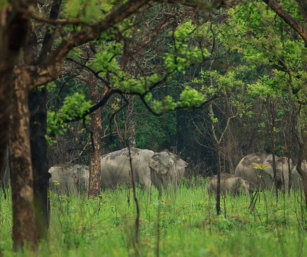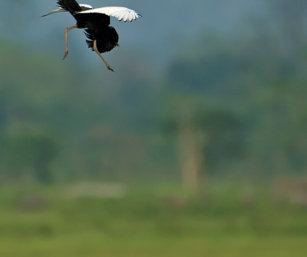Manas Tiger Reserve, Apr 2010
Bengal Floricans and Golden Langurs
I have always wanted to go to Manas in West Assam and finally the chance came when it was chosen as the best location to photograph the critically threatened Bengal Florican — the world’s rarest bustard. What started out as an effort to photograph the florican became a week-long trip covering all parts of the park. Like almost all my trips to the Northeast, Help Tourism helped me with the itinerary targeting community conservation tourism initiatives in and around the reserve.

Manas is an absolutely fantastic park — obviously with its own and very serious conservation pressures — offering fantastic habitat for a wide range of rare and threatened wildlife. Militant Bodo tribal rebels set up training camps inside the dense Manas forest and destroyed most of the forest department’s infrastructure not to mention the wildlife. Stability returned to the region in 2004 after the demarcation and declaration of a separate Bodoland Autonomous Council (BTC). Peace has returned to Manas and it is like an ‘Eastern Corbett’ of sorts — dense jungle, grasslands & clearings, the beautiful Manas river and the contiguous forests and mountains of Bhutan to the North.
We visited three parts — Koklabari on the east (for the floricans), the picturesque Mothanguri (the heart of the national park) and lastly, Ultapani on the west (for golden langurs and hornbills). The first and the third have a loose reserved forest status though part of the overall Manas biosphere reserve. As mentioned, the main motivation to visit Manas was to locate the world’s rarest bustard. To our pleasant surprise they are flourishing in Manas and we counted more than ten floricans (including a female), all of them atleast half a kilometer away. India holds 85% of the world’s Bengal Florican population and Manas has India’s largest population. The breeding male’s plumage looks like an avian King Kong and they do a sort of a jump-flight in no particular frequency. Unlike the lesser florican, these males cover both vertical and horizontal distance before crash landing in grass almost head first! One image can do no justice to this phenomenal exhibition. I managed (with a lot of help from a photoshop expert) a stitched image from a series of 35-images of a single display that lasted several seconds. I missed my 800mm which was with Canon Singapore for a failed power diaphragm. A night safari near Koklabari revealed several Hispid Hare.
After a couple of days at Koklabarai we moved to the main and the most beautiful part of Manas — Mothanguri which sits prettily on the banks of the Manas river across the Bhutan border. We spent a couple of days here doing jeep safaris in the jungle and grasslands. A few rhinos were re-introduced into the park in the mid-2000’s from Pobitora WLS and Kaziranga NP and their population is on the rise. We couldn’t view any of them though given the early rains had made the park dense and un-jeepable. We saw a large herd of elephants and wild buffalo as well as a lot of grassland birds. We were keen to see Golden Langurs at close range (though they are visible on the tree-tops at sunset on the Bhutan side more than a kilometre away) but this was ruled out because passage to Bhutan was not possible by road or river. The river was in spate and a fresh landslide had taken the road down a steep slope. The only option left for us to attempt to travel a full day to western tip of Manas to Ulta Pani (in India!) — supposedly a haven for the Golden Langurs among other things. It was, indeed. We did not regret the terrible roads as we were rewarded with some fantastic sightings of the Langurs. We actually saw three different troupes just off the road. In the evening, we counted atleast 40 Wreathed Hornbills coming into roost near camp. The next morning we drove to Guwahati to return home.
It is absolutely critical to mention the role of voluntary NGOs working in various parts of the park. Manas Maozigendri Ecotourism Society (MMES) operates in Koklabari and are the saviours of the Florican. In addition, to their guards operating anti-poaching and anti-felling activities in 11 protection camps inside Manas. Rustom Basumatary (+91-94352-95751) who works for MMES is a fantastic naturalist guide. He is also the best person in the world who can guarantee a florican sighting! Manas Ever Welfare Society (MEWS) in Gyatigaon near Bansbari leads community-based ecotourism efforts in the Mothanguri area. They also run the Florican lodge near the Bansbari forest gate. Finally, and not the least, is the Manas Biodiversity Conservation Society in Ultapani (BCSU) . The husband-wife team of Rana and Sumitra Chaudhury do stellar work in Ultapani (with little external assistance) voluntary forest protection (anti-poaching & felling) operations. The prospering Golden Langur populations is living testimony to their protection. Hats off to these warriors!






















































